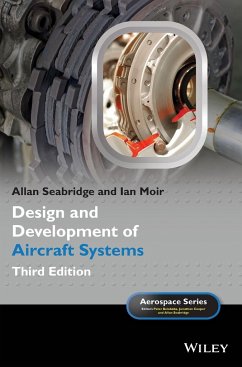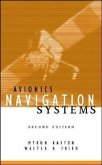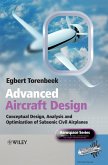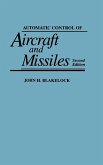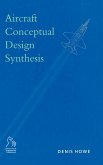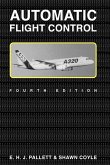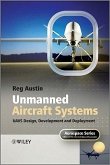Allan Seabridge, Ian Moir
Design and Development of Aircraft Systems
Herausgeber: Belobaba, Peter; Cooper, Jonathan
Allan Seabridge, Ian Moir
Design and Development of Aircraft Systems
Herausgeber: Belobaba, Peter; Cooper, Jonathan
- Gebundenes Buch
Andere Kunden interessierten sich auch für
![Avionics Navigation Systems Avionics Navigation Systems]() Myron KaytonAvionics Navigation Systems206,99 €
Myron KaytonAvionics Navigation Systems206,99 €![Advanced Aircraft Design Advanced Aircraft Design]() Egbert TorenbeekAdvanced Aircraft Design128,99 €
Egbert TorenbeekAdvanced Aircraft Design128,99 €![Unmanned Aircraft Systems Unmanned Aircraft Systems]() Unmanned Aircraft Systems252,99 €
Unmanned Aircraft Systems252,99 €![Automatic Control of Aircraft and Missiles Automatic Control of Aircraft and Missiles]() John H BlakelockAutomatic Control of Aircraft and Missiles250,99 €
John H BlakelockAutomatic Control of Aircraft and Missiles250,99 €![Aircraft Conceptual Design Synthesis Aircraft Conceptual Design Synthesis]() Denis HoweAircraft Conceptual Design Synthesis240,99 €
Denis HoweAircraft Conceptual Design Synthesis240,99 €![Automatic Flight Control 4e Automatic Flight Control 4e]() E H J PallettAutomatic Flight Control 4e98,99 €
E H J PallettAutomatic Flight Control 4e98,99 €![Unmanned Aircraft Systems Unmanned Aircraft Systems]() Reg AustinUnmanned Aircraft Systems133,99 €
Reg AustinUnmanned Aircraft Systems133,99 €-
-
-
Produktdetails
- Verlag: Wiley
- 3rd edition
- Seitenzahl: 400
- Erscheinungstermin: 6. April 2020
- Englisch
- Abmessung: 250mm x 175mm x 26mm
- Gewicht: 862g
- ISBN-13: 9781119611509
- ISBN-10: 1119611504
- Artikelnr.: 57830030
- Herstellerkennzeichnung
- Libri GmbH
- Europaallee 1
- 36244 Bad Hersfeld
- gpsr@libri.de
Allan Seabridge has over 50 years of experience in aerospace systems engineering, business development, and research & development, and has developed systems and engineering courses at UK universities. He has retired from full time engineering and enjoys spending time at an aircraft company heritage group. Ian Moir spent 20 years as an Engineering Officer in the Royal Air Force and has broad and detailed experience working in aircraft avionics systems at a major UK avionics company. Ian has now retired from aerospace activities and is enjoying a life of leisure in the Cotswolds, whilst retaining an interest in aerospace.
About the Authors xiii
Series Preface xv
Acknowledgements xvii
Glossary of Terms xix
1 Introduction 1
1.1 General 1
1.2 Systems Development 3
1.3 Skills 8
1.4 Human Aspects 9
1.4.1 Introduction 9
1.4.2 Design Considerations 10
1.4.3 Legislation 12
1.4.4 Summary of Legal Threats 12
1.4.5 Conclusions 13
1.5 Overview 14
Exercises 17
References 17
Further Reading 17
2 The Aircraft Systems 19
2.1 Introduction 19
2.2 Definitions 19
2.3 Everyday Examples of Systems 21
2.4 Aircraft Systems of Interest 24
2.4.1 Airframe Systems 28
2.4.2 Vehicle Systems 28
2.4.3 Interface Characteristics of Vehicle Systems 30
2.4.4 Avionics Systems 31
2.4.5 Interface Characteristics of Vehicle and Avionics Systems 31
2.4.5.1 Vehicle Systems 32
2.4.5.2 Avionics Systems 32
2.4.6 Mission Systems 32
2.4.7 Interface Characteristics of Mission Systems 33
2.5 Ground Systems 33
2.6 Generic System Definition 34
Exercises 37
References 37
Further Reading 37
3 The Design and Development Process 39
3.1 Introduction 39
3.2 Definitions 39
3.3 The Product Lifecycle 41
3.4 Concept Phase 46
3.4.1 Engineering Process 48
3.4.2 Engineering Skills 48
3.5 Definition Phase 50
3.5.1 Engineering Process 52
3.5.2 Engineering Skills 53
3.6 Design Phase 56
3.6.1 Engineering Process 56
3.6.2 Engineering Skills 57
3.7 Build Phase 58
3.7.1 Engineering Process 59
3.7.2 Engineering Skills 59
3.8 Test Phase 60
3.8.1 Engineering Process 60
3.8.2 Engineering Skills 60
3.9 Operate Phase 61
3.9.1 Engineering Process 62
3.9.2 Engineering Skills 63
3.10 Disposal or Retirement Phase 63
3.10.1 Engineering Process 65
3.10.2 Engineering Skills 65
3.11 Refurbishment Phase 65
3.11.1 Engineering Process 66
3.11.2 Engineering Skills 66
3.12 Whole Lifecycle Tasks 66
3.13 Summary 67
Exercises 69
References 70
Further Reading 70
4 Design Drivers 73
4.1 Introduction 73
4.2 Design Drivers in the Business Environment 75
4.2.1 Customer 76
4.2.2 Market and Competition 76
4.2.3 Capacity 77
4.2.4 Financial Issues 77
4.2.5 Defence Policy 78
4.2.6 Leisure and Business Interests 78
4.2.7 Politics 79
4.2.8 Technology 79
4.2.9 Global Economy 80
4.3 Design Drivers in the Project Environment 80
4.3.1 Standards and Regulations 80
4.3.2 Availability 81
4.3.3 Cost 81
4.3.4 Programme 82
4.3.5 Performance 82
4.3.6 Skills and Resources 82
4.3.7 Health, Safety, and Environmental Issues 83
4.3.8 Risk 84
4.4 Design Drivers in the Product Environment 84
4.4.1 Functional Performance 84
4.4.2 Human-Machine Interface 85
4.4.3 Crew and Passengers 86
4.4.4 Stores and Cargo 86
4.4.5 Structure 87
4.4.6 Safety 87
4.4.7 Quality 87
4.4.8 Environmental Conditions 87
4.5 Design Drivers in the Product Operating Environment 88
4.5.1 Heat 88
4.5.2 Noise 89
4.5.3 RF Radiation 89
4.5.4 Solar Energy 90
4.5.5 Altitude 91
4.5.6 Temperature 91
4.5.7 Contaminants, and Destructive and Hazardous Substances 92
4.5.8 Lightning 92
4.5.9 Nuclear, Biological, and Chemical Contamination 92
4.5.10 Vibration 93
4.5.11 Shock 93
4.6 Interfaces with the Sub-system Environment 93
4.6.1 Physical Interfaces 94
4.6.2 Power Interfaces 94
4.6.3 Data Communication Interfaces 95
4.6.4 Input/Output Interfaces 95
4.6.5 Status/Discrete Data 95
4.7 Obsolescence 96
4.7.1 Introduction 96
4.7.2 The Threat of Obsolescence in the Product Lifecycle 97
4.7.2.1 Requirements Specification 98
4.7.2.2 People 99
4.7.2.3 Regulations 101
4.7.2.4 Design, Development, and Manufacture 101
4.7.2.5 The Supply Chain 103
4.7.3 Managing Obsolescence 103
4.8 Ageing Aircraft 106
4.8.1 Introduction 106
4.8.2 Some Examples 107
4.8.3 Systems Issues 108
4.8.4 Certification Issues 109
Exercises 109
References 110
Further Reading 110
5 System Architectures 113
5.1 Introduction 113
5.2 Definitions 114
5.3 System Architectures 115
5.3.1 Vehicle Systems 117
5.3.2 Avionic Systems 118
5.3.3 Mission Systems 118
5.3.4 Cabin Systems 119
5.3.5 Data Bus 119
5.4 Architecture Modelling and Trade-off 120
5.5 Example of a Developing Architecture 123
5.6 Evolution of Avionics Architectures 126
5.6.1 Distributed Analogue Architecture 127
5.6.2 Distributed Digital Architecture 128
5.6.3 Federated Digital Architecture 130
5.6.4 Integrated Modular Architecture 132
5.7 Example Architectures 135
5.7.1 Example 1: System Architecture 135
5.7.2 Example 2: Flight Control System 136
5.7.3 Example 3: Radar System 138
5.7.4 Example 4: Vehicle Systems Management 139
Exercises 149
References 149
Further Reading 149
6 System Integration 151
6.1 Introduction 151
6.2 Definitions 153
6.3 Examples of System Integration 153
6.3.1 Integration at the Component Level 153
6.3.2 Integration at the System Level 154
6.3.3 Integration at the Process Level 160
6.3.4 Integration at the Functional Level 163
6.3.5 Integration at the Information Level 166
6.3.6 Integration at the Prime Contractor Level 166
6.3.7 Integration Arising from Emergent Properties 167
6.3.8 Further Examples of Integrated Systems 169
6.3.8.1 The Airframe 169
6.3.8.2 Propulsion 171
6.3.8.3 Air Systems 171
6.4 System Integration Skills 172
6.5 Management of System Integration 175
6.5.1 Major Activities 175
6.5.2 Major Milestones 175
6.5.3 Decomposition and Definition Process 178
6.5.4 Integration and Verification Process 178
6.5.5 Component Engineering 178
6.6 Highly Integrated Systems 178
6.6.1 Integration of Primary Flight Control Systems 179
6.7 Discussion 182
Exercises 184
References 186
Further Reading 186
7 Verification of System Requirements 187
7.1 Introduction 187
7.2 Gathering Qualification Evidence in the Lifecycle 189
7.3 Test Methods 191
7.3.1 Inspection of Design 192
7.3.2 Calculation 192
7.3.3 Analogy 193
7.3.4 Modelling and Simulation 193
7.3.4.1 Modelling Techniques 197
7.3.5 Test Rigs 206
7.3.6 Environmental Testing 207
7.3.7 Integration Test Rigs 207
7.3.8 Aircraft Ground Testing 209
7.3.9 Flight Test 210
7.3.10 Trials 211
7.3.11 Operational Test 212
7.3.12 Demonstrations 212
7.4 An Example Using a Radar System 212
7.5 Summary 214
Exercises 215
References 215
Further Reading 216
8 Practical Considerations 217
8.1 Introduction 217
8.2 Stakeholders 218
8.2.1 Identification of Stakeholders 218
8.2.2 Classification of Stakeholders 219
8.3 Communications 220
8.3.1 The Nature of Communication 222
8.3.2 Examples of Organisation Communication Media 223
8.3.2.1 Mechanisms for Generating Information 225
8.3.2.2 Unauthorised Access 225
8.3.2.3 Data Storage and Access 226
8.3.2.4 Data Discipline 227
8.3.3 The Cost of Poor Communication 227
8.3.4 A Lesson Learned 228
8.4 Giving and Receiving Criticism 230
8.4.1 The Need for Criticism in the Design Process 230
8.4.2 The Nature of Criticism 230
8.4.3 Behaviours Associated with Criticism 231
8.4.4 Conclusions 232
8.5 Supplier Relationships 232
8.6 Engineering Judgement 234
8.7 Complexity 234
8.8 Emergent Properties 235
8.9 Aircraft Wiring and Connectors 236
8.9.1 Aircraft Wiring 236
8.9.2 Aircraft Breaks 237
8.9.3 Wiring Bundle Definition 238
8.9.4 Wiring Routing 239
8.9.5 Wiring Sizing 239
8.9.6 Aircraft Electrical Signal Types 241
8.9.7 Electrical Segregation 242
8.9.8 The Nature of Aircraft Wiring and Connectors 242
8.9.9 Use of Twisted Pairs and Quads 244
8.10 Bonding and Grounding 246
Exercise 248
References 248
Further Reading 248
9 Configuration Control 249
9.1 Introduction 249
9.2 Configuration Control Process 249
9.3 A Simple Portrayal of a System 250
9.4 Varying System Configurations 252
9.4.1 System Configuration A 252
9.4.2 System Configuration B 253
9.4.3 System Configuration C 254
9.5 Forwards and Backwards Compatibility 255
9.5.1 Forwards Compatibility 255
9.5.2 Backwards Compatibility 256
9.6 Factors Affecting Compatibility 256
9.6.1 Hardware 257
9.6.2 Software 257
9.6.3 Wiring 258
9.7 System Evolution 258
9.8 Configuration Control 259
9.8.1 Airbus A380 Example 261
9.9 Interface Control 264
9.9.1 Interface Control Document 264
9.9.2 Aircraft-level Data Bus Data 266
9.9.3 System Internal Data Bus Data 266
9.9.4 Internal System Input/Output Data 267
9.9.5 Fuel Component Interfaces 267
9.10 Control of Day-to-Day Documents 267
Exercise 268
10 Aircraft System Examples 269
10.1 Introduction 269
10.2 Design Considerations 269
10.3 Safety and Economic Considerations 271
10.4 Failure Severity Categorisation 272
10.5 Design Assurance Levels 272
10.6 Redundancy 273
10.6.1 Architecture Options 274
10.6.1.1 Simplex Architecture 274
10.6.1.2 Duplex Architecture 276
10.6.1.3 Dual/Dual Architecture 276
10.6.1.4 Triplex Architecture 276
10.6.1.5 Quadruplex Architecture 276
10.6.2 System Examples 277
10.6.2.1 Major Systems Event 277
10.6.2.2 Flight Critical Event 278
10.7 Integration of Aircraft Systems 280
10.7.1 Engine Control System 282
10.7.2 Flight Control System 283
10.7.3 Attitude Measurement System 284
10.7.4 Air Data System 284
10.7.5 Electrical Power System 285
10.7.6 Hydraulic Power System 286
10.8 Integration of Avionics Systems 287
References 290
11 Integration and Complexity: The Potential Impact on Flight Safety 291
11.1 Introduction 291
11.2 Integration 291
11.3 Complexity 294
11.4 Automation 298
11.5 Impact on Flight Safety Discussion 299
11.6 Single-pilot Operations 302
11.7 Postscript: Chaos Discussion 303
Exercises 307
References 307
Further Reading 308
12 Key Characteristics of Aircraft Systems 309
12.1 Introduction 309
12.2 Aircraft Systems 311
12.3 Avionics Systems 326
12.4 Mission Systems 336
12.5 Sizing and Scoping Systems 343
12.6 Analysis of the Fuel Penalties of Aircraft Systems 345
12.6.1 Introduction 345
12.6.2 Basic Formulation of Fuel Weight Penalties of Systems 346
12.6.3 Application of Fuel Weight Penalties Formulation for Multi-phase
Flight 349
12.6.4 Analysis of Fuel Weight Penalties Formulation for Multi-phase Flight
350
12.6.5 Use of Fuel Weight Penalties to Compare Systems 350
12.6.6 Determining Input Data for Systems Weight Penalties Analysis 351
12.6.6.1 Lift/Drag Ratio 351
12.6.6.2 Specific Fuel Consumption 352
12.6.6.3 System Mass 352
12.6.6.4 System Drag Increase 352
12.6.6.5 Increase in sfc Due to Systems Power Off-takes 352
Nomenclature 354
References 354
13 Conclusions 357
13.1 What's Next? 359
13.2 A Historical Footnote 361
References 362
Index 363
Series Preface xv
Acknowledgements xvii
Glossary of Terms xix
1 Introduction 1
1.1 General 1
1.2 Systems Development 3
1.3 Skills 8
1.4 Human Aspects 9
1.4.1 Introduction 9
1.4.2 Design Considerations 10
1.4.3 Legislation 12
1.4.4 Summary of Legal Threats 12
1.4.5 Conclusions 13
1.5 Overview 14
Exercises 17
References 17
Further Reading 17
2 The Aircraft Systems 19
2.1 Introduction 19
2.2 Definitions 19
2.3 Everyday Examples of Systems 21
2.4 Aircraft Systems of Interest 24
2.4.1 Airframe Systems 28
2.4.2 Vehicle Systems 28
2.4.3 Interface Characteristics of Vehicle Systems 30
2.4.4 Avionics Systems 31
2.4.5 Interface Characteristics of Vehicle and Avionics Systems 31
2.4.5.1 Vehicle Systems 32
2.4.5.2 Avionics Systems 32
2.4.6 Mission Systems 32
2.4.7 Interface Characteristics of Mission Systems 33
2.5 Ground Systems 33
2.6 Generic System Definition 34
Exercises 37
References 37
Further Reading 37
3 The Design and Development Process 39
3.1 Introduction 39
3.2 Definitions 39
3.3 The Product Lifecycle 41
3.4 Concept Phase 46
3.4.1 Engineering Process 48
3.4.2 Engineering Skills 48
3.5 Definition Phase 50
3.5.1 Engineering Process 52
3.5.2 Engineering Skills 53
3.6 Design Phase 56
3.6.1 Engineering Process 56
3.6.2 Engineering Skills 57
3.7 Build Phase 58
3.7.1 Engineering Process 59
3.7.2 Engineering Skills 59
3.8 Test Phase 60
3.8.1 Engineering Process 60
3.8.2 Engineering Skills 60
3.9 Operate Phase 61
3.9.1 Engineering Process 62
3.9.2 Engineering Skills 63
3.10 Disposal or Retirement Phase 63
3.10.1 Engineering Process 65
3.10.2 Engineering Skills 65
3.11 Refurbishment Phase 65
3.11.1 Engineering Process 66
3.11.2 Engineering Skills 66
3.12 Whole Lifecycle Tasks 66
3.13 Summary 67
Exercises 69
References 70
Further Reading 70
4 Design Drivers 73
4.1 Introduction 73
4.2 Design Drivers in the Business Environment 75
4.2.1 Customer 76
4.2.2 Market and Competition 76
4.2.3 Capacity 77
4.2.4 Financial Issues 77
4.2.5 Defence Policy 78
4.2.6 Leisure and Business Interests 78
4.2.7 Politics 79
4.2.8 Technology 79
4.2.9 Global Economy 80
4.3 Design Drivers in the Project Environment 80
4.3.1 Standards and Regulations 80
4.3.2 Availability 81
4.3.3 Cost 81
4.3.4 Programme 82
4.3.5 Performance 82
4.3.6 Skills and Resources 82
4.3.7 Health, Safety, and Environmental Issues 83
4.3.8 Risk 84
4.4 Design Drivers in the Product Environment 84
4.4.1 Functional Performance 84
4.4.2 Human-Machine Interface 85
4.4.3 Crew and Passengers 86
4.4.4 Stores and Cargo 86
4.4.5 Structure 87
4.4.6 Safety 87
4.4.7 Quality 87
4.4.8 Environmental Conditions 87
4.5 Design Drivers in the Product Operating Environment 88
4.5.1 Heat 88
4.5.2 Noise 89
4.5.3 RF Radiation 89
4.5.4 Solar Energy 90
4.5.5 Altitude 91
4.5.6 Temperature 91
4.5.7 Contaminants, and Destructive and Hazardous Substances 92
4.5.8 Lightning 92
4.5.9 Nuclear, Biological, and Chemical Contamination 92
4.5.10 Vibration 93
4.5.11 Shock 93
4.6 Interfaces with the Sub-system Environment 93
4.6.1 Physical Interfaces 94
4.6.2 Power Interfaces 94
4.6.3 Data Communication Interfaces 95
4.6.4 Input/Output Interfaces 95
4.6.5 Status/Discrete Data 95
4.7 Obsolescence 96
4.7.1 Introduction 96
4.7.2 The Threat of Obsolescence in the Product Lifecycle 97
4.7.2.1 Requirements Specification 98
4.7.2.2 People 99
4.7.2.3 Regulations 101
4.7.2.4 Design, Development, and Manufacture 101
4.7.2.5 The Supply Chain 103
4.7.3 Managing Obsolescence 103
4.8 Ageing Aircraft 106
4.8.1 Introduction 106
4.8.2 Some Examples 107
4.8.3 Systems Issues 108
4.8.4 Certification Issues 109
Exercises 109
References 110
Further Reading 110
5 System Architectures 113
5.1 Introduction 113
5.2 Definitions 114
5.3 System Architectures 115
5.3.1 Vehicle Systems 117
5.3.2 Avionic Systems 118
5.3.3 Mission Systems 118
5.3.4 Cabin Systems 119
5.3.5 Data Bus 119
5.4 Architecture Modelling and Trade-off 120
5.5 Example of a Developing Architecture 123
5.6 Evolution of Avionics Architectures 126
5.6.1 Distributed Analogue Architecture 127
5.6.2 Distributed Digital Architecture 128
5.6.3 Federated Digital Architecture 130
5.6.4 Integrated Modular Architecture 132
5.7 Example Architectures 135
5.7.1 Example 1: System Architecture 135
5.7.2 Example 2: Flight Control System 136
5.7.3 Example 3: Radar System 138
5.7.4 Example 4: Vehicle Systems Management 139
Exercises 149
References 149
Further Reading 149
6 System Integration 151
6.1 Introduction 151
6.2 Definitions 153
6.3 Examples of System Integration 153
6.3.1 Integration at the Component Level 153
6.3.2 Integration at the System Level 154
6.3.3 Integration at the Process Level 160
6.3.4 Integration at the Functional Level 163
6.3.5 Integration at the Information Level 166
6.3.6 Integration at the Prime Contractor Level 166
6.3.7 Integration Arising from Emergent Properties 167
6.3.8 Further Examples of Integrated Systems 169
6.3.8.1 The Airframe 169
6.3.8.2 Propulsion 171
6.3.8.3 Air Systems 171
6.4 System Integration Skills 172
6.5 Management of System Integration 175
6.5.1 Major Activities 175
6.5.2 Major Milestones 175
6.5.3 Decomposition and Definition Process 178
6.5.4 Integration and Verification Process 178
6.5.5 Component Engineering 178
6.6 Highly Integrated Systems 178
6.6.1 Integration of Primary Flight Control Systems 179
6.7 Discussion 182
Exercises 184
References 186
Further Reading 186
7 Verification of System Requirements 187
7.1 Introduction 187
7.2 Gathering Qualification Evidence in the Lifecycle 189
7.3 Test Methods 191
7.3.1 Inspection of Design 192
7.3.2 Calculation 192
7.3.3 Analogy 193
7.3.4 Modelling and Simulation 193
7.3.4.1 Modelling Techniques 197
7.3.5 Test Rigs 206
7.3.6 Environmental Testing 207
7.3.7 Integration Test Rigs 207
7.3.8 Aircraft Ground Testing 209
7.3.9 Flight Test 210
7.3.10 Trials 211
7.3.11 Operational Test 212
7.3.12 Demonstrations 212
7.4 An Example Using a Radar System 212
7.5 Summary 214
Exercises 215
References 215
Further Reading 216
8 Practical Considerations 217
8.1 Introduction 217
8.2 Stakeholders 218
8.2.1 Identification of Stakeholders 218
8.2.2 Classification of Stakeholders 219
8.3 Communications 220
8.3.1 The Nature of Communication 222
8.3.2 Examples of Organisation Communication Media 223
8.3.2.1 Mechanisms for Generating Information 225
8.3.2.2 Unauthorised Access 225
8.3.2.3 Data Storage and Access 226
8.3.2.4 Data Discipline 227
8.3.3 The Cost of Poor Communication 227
8.3.4 A Lesson Learned 228
8.4 Giving and Receiving Criticism 230
8.4.1 The Need for Criticism in the Design Process 230
8.4.2 The Nature of Criticism 230
8.4.3 Behaviours Associated with Criticism 231
8.4.4 Conclusions 232
8.5 Supplier Relationships 232
8.6 Engineering Judgement 234
8.7 Complexity 234
8.8 Emergent Properties 235
8.9 Aircraft Wiring and Connectors 236
8.9.1 Aircraft Wiring 236
8.9.2 Aircraft Breaks 237
8.9.3 Wiring Bundle Definition 238
8.9.4 Wiring Routing 239
8.9.5 Wiring Sizing 239
8.9.6 Aircraft Electrical Signal Types 241
8.9.7 Electrical Segregation 242
8.9.8 The Nature of Aircraft Wiring and Connectors 242
8.9.9 Use of Twisted Pairs and Quads 244
8.10 Bonding and Grounding 246
Exercise 248
References 248
Further Reading 248
9 Configuration Control 249
9.1 Introduction 249
9.2 Configuration Control Process 249
9.3 A Simple Portrayal of a System 250
9.4 Varying System Configurations 252
9.4.1 System Configuration A 252
9.4.2 System Configuration B 253
9.4.3 System Configuration C 254
9.5 Forwards and Backwards Compatibility 255
9.5.1 Forwards Compatibility 255
9.5.2 Backwards Compatibility 256
9.6 Factors Affecting Compatibility 256
9.6.1 Hardware 257
9.6.2 Software 257
9.6.3 Wiring 258
9.7 System Evolution 258
9.8 Configuration Control 259
9.8.1 Airbus A380 Example 261
9.9 Interface Control 264
9.9.1 Interface Control Document 264
9.9.2 Aircraft-level Data Bus Data 266
9.9.3 System Internal Data Bus Data 266
9.9.4 Internal System Input/Output Data 267
9.9.5 Fuel Component Interfaces 267
9.10 Control of Day-to-Day Documents 267
Exercise 268
10 Aircraft System Examples 269
10.1 Introduction 269
10.2 Design Considerations 269
10.3 Safety and Economic Considerations 271
10.4 Failure Severity Categorisation 272
10.5 Design Assurance Levels 272
10.6 Redundancy 273
10.6.1 Architecture Options 274
10.6.1.1 Simplex Architecture 274
10.6.1.2 Duplex Architecture 276
10.6.1.3 Dual/Dual Architecture 276
10.6.1.4 Triplex Architecture 276
10.6.1.5 Quadruplex Architecture 276
10.6.2 System Examples 277
10.6.2.1 Major Systems Event 277
10.6.2.2 Flight Critical Event 278
10.7 Integration of Aircraft Systems 280
10.7.1 Engine Control System 282
10.7.2 Flight Control System 283
10.7.3 Attitude Measurement System 284
10.7.4 Air Data System 284
10.7.5 Electrical Power System 285
10.7.6 Hydraulic Power System 286
10.8 Integration of Avionics Systems 287
References 290
11 Integration and Complexity: The Potential Impact on Flight Safety 291
11.1 Introduction 291
11.2 Integration 291
11.3 Complexity 294
11.4 Automation 298
11.5 Impact on Flight Safety Discussion 299
11.6 Single-pilot Operations 302
11.7 Postscript: Chaos Discussion 303
Exercises 307
References 307
Further Reading 308
12 Key Characteristics of Aircraft Systems 309
12.1 Introduction 309
12.2 Aircraft Systems 311
12.3 Avionics Systems 326
12.4 Mission Systems 336
12.5 Sizing and Scoping Systems 343
12.6 Analysis of the Fuel Penalties of Aircraft Systems 345
12.6.1 Introduction 345
12.6.2 Basic Formulation of Fuel Weight Penalties of Systems 346
12.6.3 Application of Fuel Weight Penalties Formulation for Multi-phase
Flight 349
12.6.4 Analysis of Fuel Weight Penalties Formulation for Multi-phase Flight
350
12.6.5 Use of Fuel Weight Penalties to Compare Systems 350
12.6.6 Determining Input Data for Systems Weight Penalties Analysis 351
12.6.6.1 Lift/Drag Ratio 351
12.6.6.2 Specific Fuel Consumption 352
12.6.6.3 System Mass 352
12.6.6.4 System Drag Increase 352
12.6.6.5 Increase in sfc Due to Systems Power Off-takes 352
Nomenclature 354
References 354
13 Conclusions 357
13.1 What's Next? 359
13.2 A Historical Footnote 361
References 362
Index 363
About the Authors xiii
Series Preface xv
Acknowledgements xvii
Glossary of Terms xix
1 Introduction 1
1.1 General 1
1.2 Systems Development 3
1.3 Skills 8
1.4 Human Aspects 9
1.4.1 Introduction 9
1.4.2 Design Considerations 10
1.4.3 Legislation 12
1.4.4 Summary of Legal Threats 12
1.4.5 Conclusions 13
1.5 Overview 14
Exercises 17
References 17
Further Reading 17
2 The Aircraft Systems 19
2.1 Introduction 19
2.2 Definitions 19
2.3 Everyday Examples of Systems 21
2.4 Aircraft Systems of Interest 24
2.4.1 Airframe Systems 28
2.4.2 Vehicle Systems 28
2.4.3 Interface Characteristics of Vehicle Systems 30
2.4.4 Avionics Systems 31
2.4.5 Interface Characteristics of Vehicle and Avionics Systems 31
2.4.5.1 Vehicle Systems 32
2.4.5.2 Avionics Systems 32
2.4.6 Mission Systems 32
2.4.7 Interface Characteristics of Mission Systems 33
2.5 Ground Systems 33
2.6 Generic System Definition 34
Exercises 37
References 37
Further Reading 37
3 The Design and Development Process 39
3.1 Introduction 39
3.2 Definitions 39
3.3 The Product Lifecycle 41
3.4 Concept Phase 46
3.4.1 Engineering Process 48
3.4.2 Engineering Skills 48
3.5 Definition Phase 50
3.5.1 Engineering Process 52
3.5.2 Engineering Skills 53
3.6 Design Phase 56
3.6.1 Engineering Process 56
3.6.2 Engineering Skills 57
3.7 Build Phase 58
3.7.1 Engineering Process 59
3.7.2 Engineering Skills 59
3.8 Test Phase 60
3.8.1 Engineering Process 60
3.8.2 Engineering Skills 60
3.9 Operate Phase 61
3.9.1 Engineering Process 62
3.9.2 Engineering Skills 63
3.10 Disposal or Retirement Phase 63
3.10.1 Engineering Process 65
3.10.2 Engineering Skills 65
3.11 Refurbishment Phase 65
3.11.1 Engineering Process 66
3.11.2 Engineering Skills 66
3.12 Whole Lifecycle Tasks 66
3.13 Summary 67
Exercises 69
References 70
Further Reading 70
4 Design Drivers 73
4.1 Introduction 73
4.2 Design Drivers in the Business Environment 75
4.2.1 Customer 76
4.2.2 Market and Competition 76
4.2.3 Capacity 77
4.2.4 Financial Issues 77
4.2.5 Defence Policy 78
4.2.6 Leisure and Business Interests 78
4.2.7 Politics 79
4.2.8 Technology 79
4.2.9 Global Economy 80
4.3 Design Drivers in the Project Environment 80
4.3.1 Standards and Regulations 80
4.3.2 Availability 81
4.3.3 Cost 81
4.3.4 Programme 82
4.3.5 Performance 82
4.3.6 Skills and Resources 82
4.3.7 Health, Safety, and Environmental Issues 83
4.3.8 Risk 84
4.4 Design Drivers in the Product Environment 84
4.4.1 Functional Performance 84
4.4.2 Human-Machine Interface 85
4.4.3 Crew and Passengers 86
4.4.4 Stores and Cargo 86
4.4.5 Structure 87
4.4.6 Safety 87
4.4.7 Quality 87
4.4.8 Environmental Conditions 87
4.5 Design Drivers in the Product Operating Environment 88
4.5.1 Heat 88
4.5.2 Noise 89
4.5.3 RF Radiation 89
4.5.4 Solar Energy 90
4.5.5 Altitude 91
4.5.6 Temperature 91
4.5.7 Contaminants, and Destructive and Hazardous Substances 92
4.5.8 Lightning 92
4.5.9 Nuclear, Biological, and Chemical Contamination 92
4.5.10 Vibration 93
4.5.11 Shock 93
4.6 Interfaces with the Sub-system Environment 93
4.6.1 Physical Interfaces 94
4.6.2 Power Interfaces 94
4.6.3 Data Communication Interfaces 95
4.6.4 Input/Output Interfaces 95
4.6.5 Status/Discrete Data 95
4.7 Obsolescence 96
4.7.1 Introduction 96
4.7.2 The Threat of Obsolescence in the Product Lifecycle 97
4.7.2.1 Requirements Specification 98
4.7.2.2 People 99
4.7.2.3 Regulations 101
4.7.2.4 Design, Development, and Manufacture 101
4.7.2.5 The Supply Chain 103
4.7.3 Managing Obsolescence 103
4.8 Ageing Aircraft 106
4.8.1 Introduction 106
4.8.2 Some Examples 107
4.8.3 Systems Issues 108
4.8.4 Certification Issues 109
Exercises 109
References 110
Further Reading 110
5 System Architectures 113
5.1 Introduction 113
5.2 Definitions 114
5.3 System Architectures 115
5.3.1 Vehicle Systems 117
5.3.2 Avionic Systems 118
5.3.3 Mission Systems 118
5.3.4 Cabin Systems 119
5.3.5 Data Bus 119
5.4 Architecture Modelling and Trade-off 120
5.5 Example of a Developing Architecture 123
5.6 Evolution of Avionics Architectures 126
5.6.1 Distributed Analogue Architecture 127
5.6.2 Distributed Digital Architecture 128
5.6.3 Federated Digital Architecture 130
5.6.4 Integrated Modular Architecture 132
5.7 Example Architectures 135
5.7.1 Example 1: System Architecture 135
5.7.2 Example 2: Flight Control System 136
5.7.3 Example 3: Radar System 138
5.7.4 Example 4: Vehicle Systems Management 139
Exercises 149
References 149
Further Reading 149
6 System Integration 151
6.1 Introduction 151
6.2 Definitions 153
6.3 Examples of System Integration 153
6.3.1 Integration at the Component Level 153
6.3.2 Integration at the System Level 154
6.3.3 Integration at the Process Level 160
6.3.4 Integration at the Functional Level 163
6.3.5 Integration at the Information Level 166
6.3.6 Integration at the Prime Contractor Level 166
6.3.7 Integration Arising from Emergent Properties 167
6.3.8 Further Examples of Integrated Systems 169
6.3.8.1 The Airframe 169
6.3.8.2 Propulsion 171
6.3.8.3 Air Systems 171
6.4 System Integration Skills 172
6.5 Management of System Integration 175
6.5.1 Major Activities 175
6.5.2 Major Milestones 175
6.5.3 Decomposition and Definition Process 178
6.5.4 Integration and Verification Process 178
6.5.5 Component Engineering 178
6.6 Highly Integrated Systems 178
6.6.1 Integration of Primary Flight Control Systems 179
6.7 Discussion 182
Exercises 184
References 186
Further Reading 186
7 Verification of System Requirements 187
7.1 Introduction 187
7.2 Gathering Qualification Evidence in the Lifecycle 189
7.3 Test Methods 191
7.3.1 Inspection of Design 192
7.3.2 Calculation 192
7.3.3 Analogy 193
7.3.4 Modelling and Simulation 193
7.3.4.1 Modelling Techniques 197
7.3.5 Test Rigs 206
7.3.6 Environmental Testing 207
7.3.7 Integration Test Rigs 207
7.3.8 Aircraft Ground Testing 209
7.3.9 Flight Test 210
7.3.10 Trials 211
7.3.11 Operational Test 212
7.3.12 Demonstrations 212
7.4 An Example Using a Radar System 212
7.5 Summary 214
Exercises 215
References 215
Further Reading 216
8 Practical Considerations 217
8.1 Introduction 217
8.2 Stakeholders 218
8.2.1 Identification of Stakeholders 218
8.2.2 Classification of Stakeholders 219
8.3 Communications 220
8.3.1 The Nature of Communication 222
8.3.2 Examples of Organisation Communication Media 223
8.3.2.1 Mechanisms for Generating Information 225
8.3.2.2 Unauthorised Access 225
8.3.2.3 Data Storage and Access 226
8.3.2.4 Data Discipline 227
8.3.3 The Cost of Poor Communication 227
8.3.4 A Lesson Learned 228
8.4 Giving and Receiving Criticism 230
8.4.1 The Need for Criticism in the Design Process 230
8.4.2 The Nature of Criticism 230
8.4.3 Behaviours Associated with Criticism 231
8.4.4 Conclusions 232
8.5 Supplier Relationships 232
8.6 Engineering Judgement 234
8.7 Complexity 234
8.8 Emergent Properties 235
8.9 Aircraft Wiring and Connectors 236
8.9.1 Aircraft Wiring 236
8.9.2 Aircraft Breaks 237
8.9.3 Wiring Bundle Definition 238
8.9.4 Wiring Routing 239
8.9.5 Wiring Sizing 239
8.9.6 Aircraft Electrical Signal Types 241
8.9.7 Electrical Segregation 242
8.9.8 The Nature of Aircraft Wiring and Connectors 242
8.9.9 Use of Twisted Pairs and Quads 244
8.10 Bonding and Grounding 246
Exercise 248
References 248
Further Reading 248
9 Configuration Control 249
9.1 Introduction 249
9.2 Configuration Control Process 249
9.3 A Simple Portrayal of a System 250
9.4 Varying System Configurations 252
9.4.1 System Configuration A 252
9.4.2 System Configuration B 253
9.4.3 System Configuration C 254
9.5 Forwards and Backwards Compatibility 255
9.5.1 Forwards Compatibility 255
9.5.2 Backwards Compatibility 256
9.6 Factors Affecting Compatibility 256
9.6.1 Hardware 257
9.6.2 Software 257
9.6.3 Wiring 258
9.7 System Evolution 258
9.8 Configuration Control 259
9.8.1 Airbus A380 Example 261
9.9 Interface Control 264
9.9.1 Interface Control Document 264
9.9.2 Aircraft-level Data Bus Data 266
9.9.3 System Internal Data Bus Data 266
9.9.4 Internal System Input/Output Data 267
9.9.5 Fuel Component Interfaces 267
9.10 Control of Day-to-Day Documents 267
Exercise 268
10 Aircraft System Examples 269
10.1 Introduction 269
10.2 Design Considerations 269
10.3 Safety and Economic Considerations 271
10.4 Failure Severity Categorisation 272
10.5 Design Assurance Levels 272
10.6 Redundancy 273
10.6.1 Architecture Options 274
10.6.1.1 Simplex Architecture 274
10.6.1.2 Duplex Architecture 276
10.6.1.3 Dual/Dual Architecture 276
10.6.1.4 Triplex Architecture 276
10.6.1.5 Quadruplex Architecture 276
10.6.2 System Examples 277
10.6.2.1 Major Systems Event 277
10.6.2.2 Flight Critical Event 278
10.7 Integration of Aircraft Systems 280
10.7.1 Engine Control System 282
10.7.2 Flight Control System 283
10.7.3 Attitude Measurement System 284
10.7.4 Air Data System 284
10.7.5 Electrical Power System 285
10.7.6 Hydraulic Power System 286
10.8 Integration of Avionics Systems 287
References 290
11 Integration and Complexity: The Potential Impact on Flight Safety 291
11.1 Introduction 291
11.2 Integration 291
11.3 Complexity 294
11.4 Automation 298
11.5 Impact on Flight Safety Discussion 299
11.6 Single-pilot Operations 302
11.7 Postscript: Chaos Discussion 303
Exercises 307
References 307
Further Reading 308
12 Key Characteristics of Aircraft Systems 309
12.1 Introduction 309
12.2 Aircraft Systems 311
12.3 Avionics Systems 326
12.4 Mission Systems 336
12.5 Sizing and Scoping Systems 343
12.6 Analysis of the Fuel Penalties of Aircraft Systems 345
12.6.1 Introduction 345
12.6.2 Basic Formulation of Fuel Weight Penalties of Systems 346
12.6.3 Application of Fuel Weight Penalties Formulation for Multi-phase
Flight 349
12.6.4 Analysis of Fuel Weight Penalties Formulation for Multi-phase Flight
350
12.6.5 Use of Fuel Weight Penalties to Compare Systems 350
12.6.6 Determining Input Data for Systems Weight Penalties Analysis 351
12.6.6.1 Lift/Drag Ratio 351
12.6.6.2 Specific Fuel Consumption 352
12.6.6.3 System Mass 352
12.6.6.4 System Drag Increase 352
12.6.6.5 Increase in sfc Due to Systems Power Off-takes 352
Nomenclature 354
References 354
13 Conclusions 357
13.1 What's Next? 359
13.2 A Historical Footnote 361
References 362
Index 363
Series Preface xv
Acknowledgements xvii
Glossary of Terms xix
1 Introduction 1
1.1 General 1
1.2 Systems Development 3
1.3 Skills 8
1.4 Human Aspects 9
1.4.1 Introduction 9
1.4.2 Design Considerations 10
1.4.3 Legislation 12
1.4.4 Summary of Legal Threats 12
1.4.5 Conclusions 13
1.5 Overview 14
Exercises 17
References 17
Further Reading 17
2 The Aircraft Systems 19
2.1 Introduction 19
2.2 Definitions 19
2.3 Everyday Examples of Systems 21
2.4 Aircraft Systems of Interest 24
2.4.1 Airframe Systems 28
2.4.2 Vehicle Systems 28
2.4.3 Interface Characteristics of Vehicle Systems 30
2.4.4 Avionics Systems 31
2.4.5 Interface Characteristics of Vehicle and Avionics Systems 31
2.4.5.1 Vehicle Systems 32
2.4.5.2 Avionics Systems 32
2.4.6 Mission Systems 32
2.4.7 Interface Characteristics of Mission Systems 33
2.5 Ground Systems 33
2.6 Generic System Definition 34
Exercises 37
References 37
Further Reading 37
3 The Design and Development Process 39
3.1 Introduction 39
3.2 Definitions 39
3.3 The Product Lifecycle 41
3.4 Concept Phase 46
3.4.1 Engineering Process 48
3.4.2 Engineering Skills 48
3.5 Definition Phase 50
3.5.1 Engineering Process 52
3.5.2 Engineering Skills 53
3.6 Design Phase 56
3.6.1 Engineering Process 56
3.6.2 Engineering Skills 57
3.7 Build Phase 58
3.7.1 Engineering Process 59
3.7.2 Engineering Skills 59
3.8 Test Phase 60
3.8.1 Engineering Process 60
3.8.2 Engineering Skills 60
3.9 Operate Phase 61
3.9.1 Engineering Process 62
3.9.2 Engineering Skills 63
3.10 Disposal or Retirement Phase 63
3.10.1 Engineering Process 65
3.10.2 Engineering Skills 65
3.11 Refurbishment Phase 65
3.11.1 Engineering Process 66
3.11.2 Engineering Skills 66
3.12 Whole Lifecycle Tasks 66
3.13 Summary 67
Exercises 69
References 70
Further Reading 70
4 Design Drivers 73
4.1 Introduction 73
4.2 Design Drivers in the Business Environment 75
4.2.1 Customer 76
4.2.2 Market and Competition 76
4.2.3 Capacity 77
4.2.4 Financial Issues 77
4.2.5 Defence Policy 78
4.2.6 Leisure and Business Interests 78
4.2.7 Politics 79
4.2.8 Technology 79
4.2.9 Global Economy 80
4.3 Design Drivers in the Project Environment 80
4.3.1 Standards and Regulations 80
4.3.2 Availability 81
4.3.3 Cost 81
4.3.4 Programme 82
4.3.5 Performance 82
4.3.6 Skills and Resources 82
4.3.7 Health, Safety, and Environmental Issues 83
4.3.8 Risk 84
4.4 Design Drivers in the Product Environment 84
4.4.1 Functional Performance 84
4.4.2 Human-Machine Interface 85
4.4.3 Crew and Passengers 86
4.4.4 Stores and Cargo 86
4.4.5 Structure 87
4.4.6 Safety 87
4.4.7 Quality 87
4.4.8 Environmental Conditions 87
4.5 Design Drivers in the Product Operating Environment 88
4.5.1 Heat 88
4.5.2 Noise 89
4.5.3 RF Radiation 89
4.5.4 Solar Energy 90
4.5.5 Altitude 91
4.5.6 Temperature 91
4.5.7 Contaminants, and Destructive and Hazardous Substances 92
4.5.8 Lightning 92
4.5.9 Nuclear, Biological, and Chemical Contamination 92
4.5.10 Vibration 93
4.5.11 Shock 93
4.6 Interfaces with the Sub-system Environment 93
4.6.1 Physical Interfaces 94
4.6.2 Power Interfaces 94
4.6.3 Data Communication Interfaces 95
4.6.4 Input/Output Interfaces 95
4.6.5 Status/Discrete Data 95
4.7 Obsolescence 96
4.7.1 Introduction 96
4.7.2 The Threat of Obsolescence in the Product Lifecycle 97
4.7.2.1 Requirements Specification 98
4.7.2.2 People 99
4.7.2.3 Regulations 101
4.7.2.4 Design, Development, and Manufacture 101
4.7.2.5 The Supply Chain 103
4.7.3 Managing Obsolescence 103
4.8 Ageing Aircraft 106
4.8.1 Introduction 106
4.8.2 Some Examples 107
4.8.3 Systems Issues 108
4.8.4 Certification Issues 109
Exercises 109
References 110
Further Reading 110
5 System Architectures 113
5.1 Introduction 113
5.2 Definitions 114
5.3 System Architectures 115
5.3.1 Vehicle Systems 117
5.3.2 Avionic Systems 118
5.3.3 Mission Systems 118
5.3.4 Cabin Systems 119
5.3.5 Data Bus 119
5.4 Architecture Modelling and Trade-off 120
5.5 Example of a Developing Architecture 123
5.6 Evolution of Avionics Architectures 126
5.6.1 Distributed Analogue Architecture 127
5.6.2 Distributed Digital Architecture 128
5.6.3 Federated Digital Architecture 130
5.6.4 Integrated Modular Architecture 132
5.7 Example Architectures 135
5.7.1 Example 1: System Architecture 135
5.7.2 Example 2: Flight Control System 136
5.7.3 Example 3: Radar System 138
5.7.4 Example 4: Vehicle Systems Management 139
Exercises 149
References 149
Further Reading 149
6 System Integration 151
6.1 Introduction 151
6.2 Definitions 153
6.3 Examples of System Integration 153
6.3.1 Integration at the Component Level 153
6.3.2 Integration at the System Level 154
6.3.3 Integration at the Process Level 160
6.3.4 Integration at the Functional Level 163
6.3.5 Integration at the Information Level 166
6.3.6 Integration at the Prime Contractor Level 166
6.3.7 Integration Arising from Emergent Properties 167
6.3.8 Further Examples of Integrated Systems 169
6.3.8.1 The Airframe 169
6.3.8.2 Propulsion 171
6.3.8.3 Air Systems 171
6.4 System Integration Skills 172
6.5 Management of System Integration 175
6.5.1 Major Activities 175
6.5.2 Major Milestones 175
6.5.3 Decomposition and Definition Process 178
6.5.4 Integration and Verification Process 178
6.5.5 Component Engineering 178
6.6 Highly Integrated Systems 178
6.6.1 Integration of Primary Flight Control Systems 179
6.7 Discussion 182
Exercises 184
References 186
Further Reading 186
7 Verification of System Requirements 187
7.1 Introduction 187
7.2 Gathering Qualification Evidence in the Lifecycle 189
7.3 Test Methods 191
7.3.1 Inspection of Design 192
7.3.2 Calculation 192
7.3.3 Analogy 193
7.3.4 Modelling and Simulation 193
7.3.4.1 Modelling Techniques 197
7.3.5 Test Rigs 206
7.3.6 Environmental Testing 207
7.3.7 Integration Test Rigs 207
7.3.8 Aircraft Ground Testing 209
7.3.9 Flight Test 210
7.3.10 Trials 211
7.3.11 Operational Test 212
7.3.12 Demonstrations 212
7.4 An Example Using a Radar System 212
7.5 Summary 214
Exercises 215
References 215
Further Reading 216
8 Practical Considerations 217
8.1 Introduction 217
8.2 Stakeholders 218
8.2.1 Identification of Stakeholders 218
8.2.2 Classification of Stakeholders 219
8.3 Communications 220
8.3.1 The Nature of Communication 222
8.3.2 Examples of Organisation Communication Media 223
8.3.2.1 Mechanisms for Generating Information 225
8.3.2.2 Unauthorised Access 225
8.3.2.3 Data Storage and Access 226
8.3.2.4 Data Discipline 227
8.3.3 The Cost of Poor Communication 227
8.3.4 A Lesson Learned 228
8.4 Giving and Receiving Criticism 230
8.4.1 The Need for Criticism in the Design Process 230
8.4.2 The Nature of Criticism 230
8.4.3 Behaviours Associated with Criticism 231
8.4.4 Conclusions 232
8.5 Supplier Relationships 232
8.6 Engineering Judgement 234
8.7 Complexity 234
8.8 Emergent Properties 235
8.9 Aircraft Wiring and Connectors 236
8.9.1 Aircraft Wiring 236
8.9.2 Aircraft Breaks 237
8.9.3 Wiring Bundle Definition 238
8.9.4 Wiring Routing 239
8.9.5 Wiring Sizing 239
8.9.6 Aircraft Electrical Signal Types 241
8.9.7 Electrical Segregation 242
8.9.8 The Nature of Aircraft Wiring and Connectors 242
8.9.9 Use of Twisted Pairs and Quads 244
8.10 Bonding and Grounding 246
Exercise 248
References 248
Further Reading 248
9 Configuration Control 249
9.1 Introduction 249
9.2 Configuration Control Process 249
9.3 A Simple Portrayal of a System 250
9.4 Varying System Configurations 252
9.4.1 System Configuration A 252
9.4.2 System Configuration B 253
9.4.3 System Configuration C 254
9.5 Forwards and Backwards Compatibility 255
9.5.1 Forwards Compatibility 255
9.5.2 Backwards Compatibility 256
9.6 Factors Affecting Compatibility 256
9.6.1 Hardware 257
9.6.2 Software 257
9.6.3 Wiring 258
9.7 System Evolution 258
9.8 Configuration Control 259
9.8.1 Airbus A380 Example 261
9.9 Interface Control 264
9.9.1 Interface Control Document 264
9.9.2 Aircraft-level Data Bus Data 266
9.9.3 System Internal Data Bus Data 266
9.9.4 Internal System Input/Output Data 267
9.9.5 Fuel Component Interfaces 267
9.10 Control of Day-to-Day Documents 267
Exercise 268
10 Aircraft System Examples 269
10.1 Introduction 269
10.2 Design Considerations 269
10.3 Safety and Economic Considerations 271
10.4 Failure Severity Categorisation 272
10.5 Design Assurance Levels 272
10.6 Redundancy 273
10.6.1 Architecture Options 274
10.6.1.1 Simplex Architecture 274
10.6.1.2 Duplex Architecture 276
10.6.1.3 Dual/Dual Architecture 276
10.6.1.4 Triplex Architecture 276
10.6.1.5 Quadruplex Architecture 276
10.6.2 System Examples 277
10.6.2.1 Major Systems Event 277
10.6.2.2 Flight Critical Event 278
10.7 Integration of Aircraft Systems 280
10.7.1 Engine Control System 282
10.7.2 Flight Control System 283
10.7.3 Attitude Measurement System 284
10.7.4 Air Data System 284
10.7.5 Electrical Power System 285
10.7.6 Hydraulic Power System 286
10.8 Integration of Avionics Systems 287
References 290
11 Integration and Complexity: The Potential Impact on Flight Safety 291
11.1 Introduction 291
11.2 Integration 291
11.3 Complexity 294
11.4 Automation 298
11.5 Impact on Flight Safety Discussion 299
11.6 Single-pilot Operations 302
11.7 Postscript: Chaos Discussion 303
Exercises 307
References 307
Further Reading 308
12 Key Characteristics of Aircraft Systems 309
12.1 Introduction 309
12.2 Aircraft Systems 311
12.3 Avionics Systems 326
12.4 Mission Systems 336
12.5 Sizing and Scoping Systems 343
12.6 Analysis of the Fuel Penalties of Aircraft Systems 345
12.6.1 Introduction 345
12.6.2 Basic Formulation of Fuel Weight Penalties of Systems 346
12.6.3 Application of Fuel Weight Penalties Formulation for Multi-phase
Flight 349
12.6.4 Analysis of Fuel Weight Penalties Formulation for Multi-phase Flight
350
12.6.5 Use of Fuel Weight Penalties to Compare Systems 350
12.6.6 Determining Input Data for Systems Weight Penalties Analysis 351
12.6.6.1 Lift/Drag Ratio 351
12.6.6.2 Specific Fuel Consumption 352
12.6.6.3 System Mass 352
12.6.6.4 System Drag Increase 352
12.6.6.5 Increase in sfc Due to Systems Power Off-takes 352
Nomenclature 354
References 354
13 Conclusions 357
13.1 What's Next? 359
13.2 A Historical Footnote 361
References 362
Index 363

